
LiFi vs WiFi: Understanding Core Differences
While LiFi and WiFi may sound similar, they are distinct wireless communication technologies with significant differences upon closer examination.

One uses light, and the other radio frequency waves. One is at the dawn of its expansion, the other is anchored in our daily life. As we draw a much-needed comparison between WiFi vs LiFi, we will try to understand how their functional differences can affect the trajectory of the organizations that employ them.
In an ultra-connected society where access to the Internet becomes more important than ever, which technology stands out as the winner? That is the question we will try to answer in this article.
WiFi and its Core Features
In simple terms, WiFi is a communication technology for transmitting data via radio waves.
WiFi is a wireless technology that uses radio frequency waves to transmit data across devices. It is based on a group of wireless network protocols derived from the IEEE 802.11 family of standards that are used for local area networking of devices and internet connections. Presently, Wifi is the most widely used technology for providing internet access across the globe. It depends on carrying signals through wireless routers to wireless access points on devices that receive this data carried on radio waves.
It goes without saying that WiFi has radically changed the concept of Internet connection by allowing its users to free themselves from the constraints of a wired connection. However, it has some major drawbacks inherent to its operation. First of all, WiFi, because of its large range, is a very vulnerable solution to hacking. Indeed, anyone located within the radius of the radio waves emitted by a WiFi device can undertake to hack the data circulating on it. Although there are passwords and other more or less sophisticated means of protection, the damage caused by cybercrime throughout history has proven to be far more insidious.
Secondly, the use of radio waves regularly leads to interference that results in signal drops or losses, a phenomenon that tends to increase with the constant increase in the number of connected objects. The interference caused by radio waves also makes WiFi unsuitable for certain sectors, such as aeronautics. Moreover, the impact of such exposure to radio waves on health raises questions and concerns, without any conclusive answer.
Image by Freepik
LiFi Technology and its Core Features
LiFi or light fidelity is a bi-directional system of wireless communication that transmits data as optical signals. This means that information carried by LiFi technology uses the visible spectrum of electromagnetic waves to travel from source to receptor devices. LiFi connections use LED lights to provide internet connectivity through free space optics. The communication and connectivity achieved by LiFi are much superior in speed, stability, and security when compared with traditional internet technologies.
LiFi or Light WiFi operates on visible light, the optical part of the electromagnetic spectrum. The result of years of extensive research, LiFi can now generate a high-speed internet connection of up to 1 Gb/s, equivalent to the fastest fiber optic offerings. LiFi speed and connectivity are made possible by the imperceptible pulsation of a beam of light emitted by an LED bulb located in the transmitting device (Access Point), captured by a receiving device plugged into the connected device (Dongle).
Unlike WiFi, LiFi offers absolute security of the transmitted data, because their circulation is limited exclusively to the coverage area of the light beam(s), and the information can therefore never cross walls. Beyond the cybersecurity issues, LiFi allows for uniform Internet coverage in its broadcast room. In practice, in a 32-student classroom with only two access points, each student can enjoy a super-fast, latency-free connection, even if they are surfing at the same time as everyone else.
In addition, LiFi technology works entirely without radio waves. It does not interfere with WiFi, 4G or 5G, or even with the equipment on board the aircraft. This is how Oledcomm was able to equip an Air France plane with high-speed internet in 2019 thanks to LiFi. The absence of radio frequency waves also means that LiFi is not harmful to health. Its application in schools, day-care centers, and hospitals will therefore make it possible to offer young people in development and fragile people an optimal Internet connection without danger to their health.
Also Read: How Does LiFi Work: A Step-by-Step Guide (2024)
LiFi vs WiFi: Fundamental Differences
Today, WiFi is omnipresent in our society. In homes, in companies, institutions, and communities: humans have built a mentally inseparable relationship with the internet powered by WiFi. But now there is another technology on the way to revolutionizing wireless communication. This is LiFi, for Light Fidelity, a system of data transmission by light that is similar to WiFi (almost) only in the sound of its name. In fact, although these two technologies are wireless data transmission methods, they differ in fundamental ways. As the ambitious expansion of connectivity through light becomes a reality, it's worth asking: What are the characteristic differences between LiFi and WiFi? Here is a list!
| Characteristic | LiFi | WiFi |
|---|---|---|
| Operation | Transmits data using LED light bulbs | Transmits data using radio waves through a router |
| Privacy | More secure data transmission as light signals cannot cross concrete walls | Walls do not block radio waves, so security can be compromised |
| Power consumption | Low | High |
| Interference | No interference even in high-density environments | Can face interference issues in a dense environment |
| Security | Non-hackable and non-jammable from outside | Hackable, jammable, and detectable |
| ATEX Zones | Zero electromagnetic signature | Prohibited in ATEX zones due to radio frequency waves |
Also Read: Unlocking synergy between LiFi and 5G
Future of LiFi: How Li-Fi supports the Connectivity Goals of Tomorrow?
If LiFi and WiFi both have similar qualities and purposes, their differences should make us wonder about the future of the Internet connection. But this is not a David and Goliath confrontation. The real challenge of the emergence of LiFi is not to replace one technology with another. It is above all about extending the field of possibilities in the field of telecommunications, about redesigning tomorrow's Internet connection by pushing back the limits of current technologies without giving up their advantages.
As we understand more about light communication and how LiFi works, we can customize this emerging technology to create better solutions for the future. What's exciting is that we have made a promising start, with a strong backing of R&D to support further growth. For now, we can conclude that a healthier, safer, more economical, and more ecological future is all a certainty as LiFi takes over the tech world.
To understand more about how a LiFi system could help your business grow, contact us!
Recent articles

Categories
See some more...





